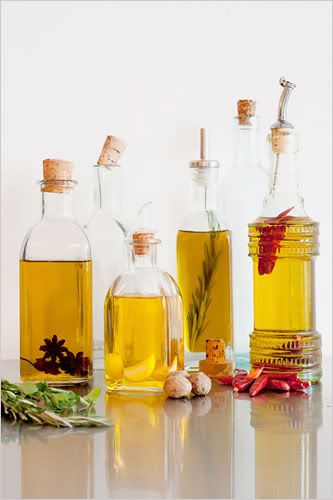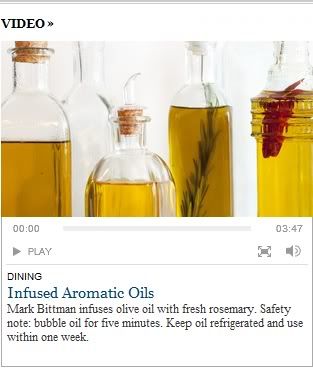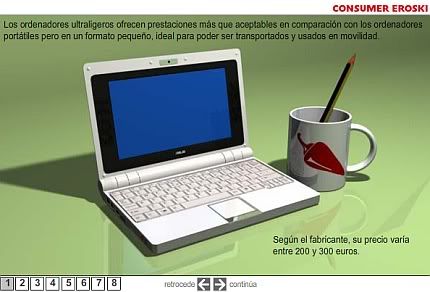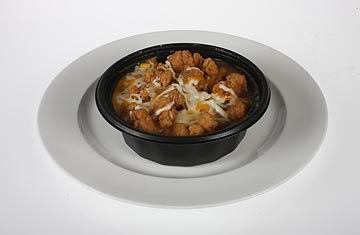La Hamburguesa perfecta y todas sus partes.
Dining & Wine | ||
| The Perfect Burger and All Its Parts By JANE SIGAL Published: June 30, 2009 | ||
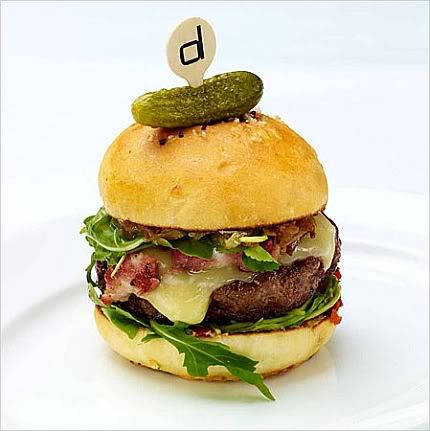 Bill Milne IT'S AN ART Hold the tomato: the Frenchie burger at DBGB includes a compote instead. | ||
| THE simple hamburger isn't so simple any more. Over the last decade or so, there has hardly been a serious chef in America who hasn't taken a shot at reinventing or improving it. They have trained their skills on every element, from the precise grind of beef to the ketchup and pickles. Some have turned their bakers loose on reformulating the bun. By most accounts, the burger's upward journey began eight years ago, when Daniel Boulud stuffed ground sirloin with truffles, braised short ribs and foie gras at his DB Bistro Moderne in Manhattan. A few weeks ago, Mr. Boulud brought things full circle, opening a burger bar on the Bowery called DBGB Kitchen and Bar. While some chefs have groused quietly about the insatiable demand for burgers, most are philosophical. "All chefs can be frustrated by the buying public sometimes," said Clark Frasier, a chef with restaurants in Massachusetts and Maine. "In this economy I'm happy to sell anything they want to eat." All this high-powered attention has produced some new ways of thinking about and cooking burgers. Interviews with 30 chefs provided dozens of lessons for the home cook that aren't terribly difficult and don't cost much money. And it all yielded the ideal burger. A PERFECT BURGER RECIPE There's a lot you can learn from a man who's griddled thousands of burgers. Michael David, executive chef at Comme Ça brasserie in Los Angeles, had already earned his burger stripes on the team that developed Mr. Boulud's French-American DB Burger.At Comme Ça, Mr. David finally nailed the consummate burger on the 11th try. The genius of his Comme Ça burger is that it is consistently juicy, perfectly seasoned and precisely medium-rare. The patty is charred on the outside and rosy pink from edge to edge. It is a radical improvement on what most people already do, but it's not much more complicated. His trick is to treat the burger the way many chefs do a steak. He puts a good hard sear on both sides using his plancha, the freight train of flat tops, then transfers it to a 375-degree oven to finish cooking. After it comes out, there's a built-in resting period while he toasts the buns and makes a last-minute lettuce salad. His method translates to an amazing amount of flexibility. Home cooks who don't have a plancha can sear the meat either on a grill or on the stovetop in a cast-iron skillet. It works equally well for one or two people, or for a crowd, because you can sear in batches. The final cooking works beautifully in a toaster oven as well as a regular oven. Or, if you have an outdoor grill that is as large as some people's kitchens, you can simply move the burgers to a cooler spot once they've been charred. Mr. David melts Cheddar cheese over the patty and dollops iceberg lettuce salad dressed with spicy mayonnaise on top and, voilà, a reformed burger. | ||
|
| ||
THE RIGHT CHOICE OF MEAT But before you get to cook the burger, you have to choose the right meat. In "Burger Bar" (Wiley, 2009), Hubert Keller writes that what you do not want is preshaped burgers or meat that is stuffed and compacted into plastic packaging. Once beef is compressed, a light texture cannot be regained. Douglas Keane, the executive chef and an owner of Cyrus and the Healdsburg Bar & Grill in Healdsburg, Calif., advises people to lose their fear of fat. He started with 80 percent lean beef, then moved to a 70-to-30 ratio. "The day I did it," he said, "the servers started coming in and asking, 'What did you do to the burger? The guests are going crazy.' " Mark Bucher, the executive chef at the Burger Joint in Washington, said that to make a great burger at home, have your butcher grind a piece of brisket. "It's got a 25- to 30-percent fat-to-meat ratio," he said. "It's gorgeous. It's my favorite." Pat LaFrieda, president of LaFrieda Wholesale Meat Purveyors, which delivers custom blends to many of the top burger restaurants in New York City, recommends grinding the meat yourself with a food processor or a mixer's grinding attachment. He prefers chuck and brisket, and said to put them in the freezer first and chill them to 30 degrees. "It's like grating cheese at home," he said. "Or coffee beans. It's better, isn't it?" He explained that preground beef is often made from the trimmings left over from steaks, roasts and stew meat. It is important, he said, to choose select, choice or prime grade meat. "When dairy cows come of age, they give a very lean, low-grade beef," he said. "That's often what's used for preground meat. That's something the consumer wants to stay away from." | ||
Multimedia:Elements of an ideal Burger. 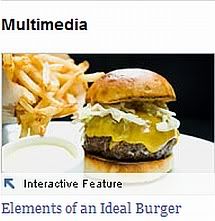 See the multimedia At NYT Website. Click here, or over the image. | ||
A NICE ROUND SHAPE Next, you form the patty. "If you do nothing else, you should handle it less," said Suvir Saran, an owner of Dévi, an Indian restaurant in Union Square. Mr. Saran, who calls himself a vegetarian who cheats, offers burgers at his restaurant, American Masala in Jersey City. Handling the raw meat too much means you're going to end up with a brick of meat. Mr. David of Comme Ça thinks a lightly shaped patty holds together better if it's refrigerated for an hour or two before cooking. Michael Mina, founder of the Mina Group, which includes the recently opened XIV in Los Angeles, rolls each patty into a ball, then presses it flat to get a nice round shape. Alternatively, jar lids are popular with chefs. Mark Richardson, the executive chef at the Four Seasons Hotel in San Francisco, swears the lid of a Hellmann's mayonnaise jar makes the best possible burger mold. Laurent Tourondel is completely against those chefs who use a whopping 12 ounces of meat. It's not too appealing to have such a thick piece of meat to bite into," said Mr. Tourondel, the executive chef and partner at the many BLT restaurants. He thinks the patty needs to be in proportion with the tomato, the bread and whatever else you have. No matter how big the patty is, one small shaping trick will help it cook better. "The first thing you do is take your thumb and make a well in the burger," said Bobby Flay, the owner of eight restaurants, including Bobby's Burger Palace, and the author, most recently, of "Bobby Flay's Burgers, Fries & Shakes" (Clarkson Potter, 2009). Tamara Murphy, the executive chef and an owner of Brasa, in Seattle, said the air and water in burgers make them puff up when they're cooked. "Nobody wants a ball of a burger," she said. "Then people take their spatula and go, smash, squishing out all the liquid." Dimpling the patty, she said, helps it cook evenly, and you won't be tempted to smack it down and lose all the juice. All the chefs agree that salt is crucial. Whether you're using kosher, table or sea salt, you should be pretty liberal with it. Beef can take more salt than you think. Most chefs recommended seasoning the burger just before cooking it. | ||
 Christopher Smith for The New York Times | ||
HOW HOT DO YOU GO? The beauty of a burger is its seared crust, and the only way to get it is to make sure the grill, skillet or flat top is hot, hot, hot. "You have to be willing to cook over high heat," said Andy D'Amico, the chef and a partner at Five Napkin Burger, in the theater district, and Nice Matin, on the Upper West Side. Testing for doneness is always a challenge for the home cook. Seamus Mullen, the chef and an owner of the Boqueria restaurants in the Flatiron district and SoHo, uses a wire cake tester. (Any thin, straight piece of metal will work as well.) "We stick it in the middle through the side," he said. "If it's barely warm to the lips, it's rare. If it's like bath water, it's medium rare. The temperature will never lie. It takes the guesswork out of everything." AND THE PERFECT BUN These chefs are focusing their laserlike attention on the bread around the meat, too. The buzzer went off for Hidefumi Kubota, the baker at Comme Ça, after Version 14 of the hamburger bun. The bun was too soft and fell apart. Or it was too hard and crushed the burger. It had to be big enough to hold the patty but not so big that you couldn't get the burger into your mouth. He ended up with a light brioche bun. Mike Plitt, the pastry chef at Arrows restaurant in Ogunquit, Me., needed about a dozen attempts before he settled on a cross between challah and a buttery dinner roll. But Ryan Skeen, who developed a following for his burgers at Resto and Irving Mill, both in Manhattan, likes Martin's brand potato rolls, sold at supermarkets up and down the East Coast. Every chef believes that the buns should be warm and crispy. SWEET, SOUR BUT FRESH FIXINGS Nothing is taken for granted, not even pickles. Some chefs have adopted the buy fresh, buy local ethic. Kyle Bailey, the chef at Allen & Delancey on the Lower East Side, for instance, found his pickles around the corner at Guss' Pickles. He especially likes the sour ones because their acidity plays off the sweetness of the ketchup, mayonnaise and bun. "You want something to cut against the richness," he said. Other chefs are applying the principle that everything is better if you make it yourself. At MC Perkins Cove in Ogunquit, Me., and Summer Winter in Burlington, Mass., Mr. Frasier pickles serrano chilies. Josh Eden, the chef and an owner at Shorty's.32 in SoHo, serves quick, house-made cucumber pickles, which get their tang from rice wine vinegar. They're extremely easy, crunchy and spiked with sweet, anise-flavored tarragon, instead of the usual dill. Cheese receives the same attention. Joey Campanaro, the chef and owner at the Little Owl in the West Village, uses American cheese. "You have the eye appeal," he said. "It looks like what a burger should look like. We're not elevating it to something it isn't." Jim Leiken, the executive chef of DBGB, said the beauty of American cheese is the texture, but rejected it in favor of Cheddar because he prefers its flavor. He also tried blue cheese for a while, but decided it overwhelmed the beef. Matt Jennings, a cheesemonger as well as a chef at Farmstead Cheese Shop, La Laiterie Bistro and Farmstead Lunch in Providence, R.I., is in an unusual position to pair cheeses and burgers. What matters most to him when selecting cheese? "Meltability," he said. So if a cheese like Gruyère doesn't melt easily, he grates it, then presses it into a disk the same size as the burger. The chefs had some final tips for creating a memorable burger. Choose lettuce that's crisp and serve it cold. Use only really good, ripe tomatoes; a bad tomato waters down the burger without adding any taste. At DBGB, Mr. Leiken replaces the tomato on his Frenchie burger with an intensely flavored house-made tomato-onion compote. Ultimately, though, it's not just the ingredients that make a burger great, said John DeLucie, the chef and a partner at the Waverly Inn in Greenwich Village. "I had a boss who wanted me to make the dish in a photo he showed me," Mr. DeLucie said. "Behind the dish was a girl in a bikini. He always wanted to know why the dish never tasted as good when I made it." | ||
